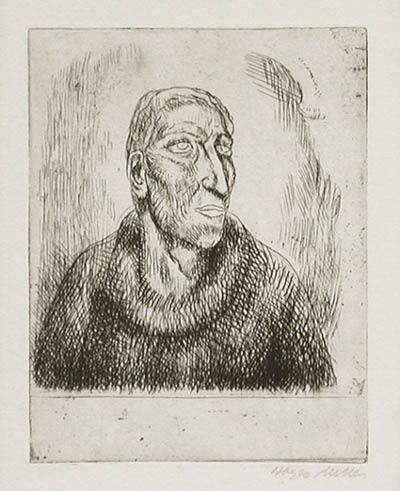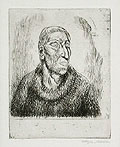| Title: |
Monk |
| Artist: |
Miller, Kenneth Hayes (Kenwood, NY, 1876 - Manhattan, 1952) |
| Date: |
c. 1930 |
| Medium: |
Original Etching & Drypoint Engraving |
| Note: |
Kenneth Hayes Miller: From his position as instructor
of painting and composition at New York's Art Student League (from 1911
to 1951) Kenneth Hayes Miller is today most often remembered as the teacher
of Edward Hopper, Reginald Marsh, Isabel Bishop, Kenneth Hartwell, Philip
Evergood and a host of other outstanding twentieth century painters and
printmakers. His influence upon these and many other artists was considerable.
Indeed, one cannot fully appreciate the course of twentieth century American
Realist art without understanding the work of this artist. |
| |
Kenneth Hayes Miller studied art at the Art Students League,
New York, under Mowbray and Cox, and at the New York School of Art, under
William M. Chase. Kenneth Hayes Miller, however, was more attracted to the work of the
great Renaissance and Baroque masters and of nineteenth century artists,
such as Delacroix and Renoir. Throughout his career he dedicated himself
to making his art a bridge between the old masters and the moderns. This
element is clearly seen in this moving portrayal entitled, Monk. |
| |
In 1923, Kenneth Hayes Miller moved his studio and home to the neighborhood
of shops, restaurants and apartments on East Fourteenth Street near Union
Square. Known as the 'Fourteenth Street School', he became a central figure
to artists who dedicated themselves to intimate portrayals of New York
City people and life. It is thus impossible to imagine the great New York
scenes of Marsh, Soyer, Hopper, Bishop and others without the path finding
art of Kenneth Hayes Miller. |
| |
Throughout his life, Kenneth Hayes Miller was as accomplished an etcher
and drypoint engraver as a painter. Of course, many of his finest students
inherited his passion for these artistic mediums. Today his art is housed
in such major American institutions as the Butler Museum of American Art,
the Cleveland Museum, the Metropolitan Museum, the Museum of Modern Art
and the Whitney Museum, New York. |
| |
"In response to the young Reginald Marsh's complaint that the
people on Fourteenth Street, whom Miller had encouraged his pupil
to paint, were ugly, the artist replied simply, 'They are ugly; they
are people. Buy a pair of field glasses.'" *
|
| Reference: |
* Nannette V. Maciejunes, "Kenneth Hayes Miller",
the Butler Museum of American Art, http://www.butlerart.com/pc_book/pages/kenneth_hayes_miller_1876.htm |
| |
G. B. Opitz, "Mantle Fielding's Dictionary of American
Painters, Sculptors and Engravers", New York, Apollo Books, 1987,
p. 624. |
| Size: |
4 7/8 X 3 7/8 (Sizes in inches are approximate, height preceding width of plate-mark or image.) |
| |
Framed and Matted with 100% Archival Materials |
| |
View larger Framed Image |
| |
 |
| Condition: |
Printed upon laid paper and with wide, full margins as published
in New York around 1930. A strongly printed, fine impression and in very
good condition throughout. Signed, "Hayes Miller", in pencil under the
plate-mark. Monk represents a prime, original example of the famous
etched art of Kenneth Hayes Miller. |
| Price: |
Sold - The price is no longer available. |
| Important Information: |
The artist biographies, research and or information pertaining to all the original works of art posted on our pages has been written and designed by Greg & Connie Peters exclusively for our site, (www.artoftheprint.com). Please visit us regularly to view the latest artworks offered for sale. We will soon be posting an update of our most recent research and include the biographical and historical information pertaining to our next collection of original works of art created by artists throughout the centuries. We hope you found the information you were looking for and that it has been beneficial.
Our Gallery, (Art of the Print / www.artoftheprint.com) guarantees the authenticity of every work of art we sell 100%. Full documentation and certification is provided. We offer a wide selection of international fine art dating from the early Renaissance to the contemporary art period. |








![]()
![]() or
phone Greg & Connie (905) 957-6666
or
phone Greg & Connie (905) 957-6666